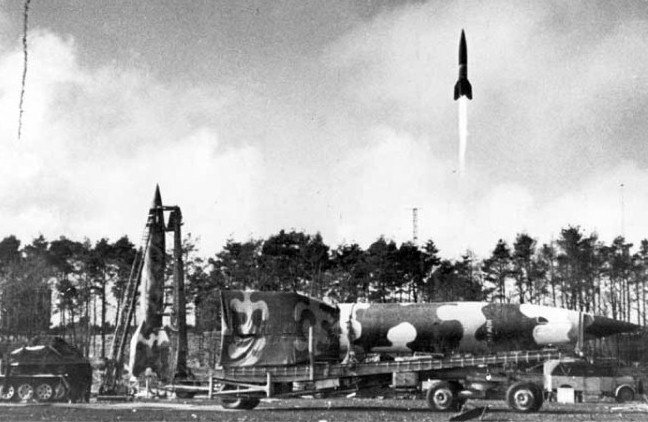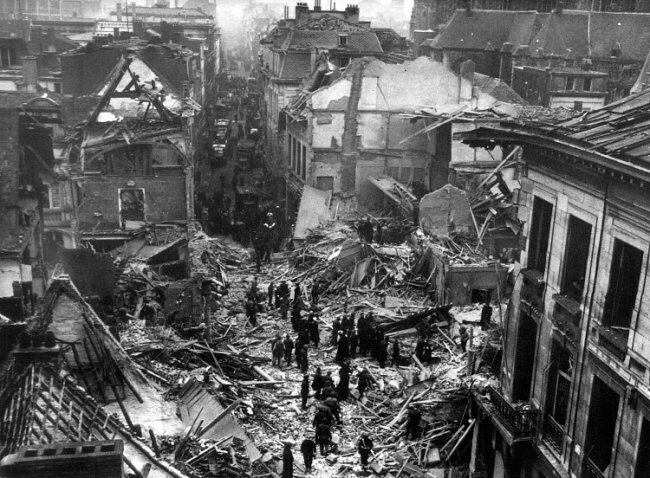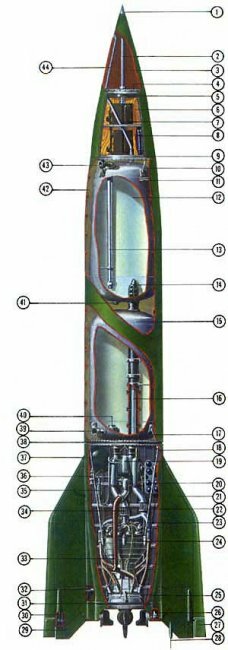FAU missiles - "weapon of retaliation"
Germany’s capitulation in 1918 and the Versailles peace treaty that followed became the starting point for creating a new species. weapons. According to the agreement, Germany was limited in the production and development of weapons, and the German army was forbidden to be in service Tanks, airplanes, submarines and even airships. But there was not a word about the nascent rocket technology in the agreement.

In 1920, many German engineers worked on the development of rocket engines. But only in 1931, the designers Riedel and Nebel managed to create a full-fledged liquid-fuel jet engine. In 1932, this engine was repeatedly tested on experienced rockets and showed encouraging results.
In the same year, star Werner von Braun, who received a bachelor’s degree from the Berlin Institute of Technology, began to rise. A talented student attracted the attention of engineer Nebel, and the 19-year-old baron simultaneously with his studies becomes an apprentice in the rocket design bureau.
In 1934, Brown defended a dissertation entitled "Constructive, Theoretical, and Experimental Contribution to the Problem of a Liquid Missile." Behind the foggy doctoral formulation was the theoretical foundations of the advantages of liquid rocket engines over bomber missiles aviation and artillery. After receiving his Ph.D. diploma, von Braun attracted the attention of the military, and the diploma was strictly classified.
In 1934, a test laboratory West was set up near Berlin, which was located at the Kummersdorf test site. It was the “cradle” of the German missiles — tests of jet engines were conducted there, dozens of prototypes of rockets were launched. Total secrecy reigned at the test site - few knew what the Brown research team was doing. In 1939, in the north of Germany, not far from the city of Peenemünde, a rocket center was founded - factory workshops and the largest wind tunnel in Europe.
In 1941, under the leadership of Brown, a new 13-ton Rocket A-4 with a liquid-fuel engine was designed.
In July, an experimental batch of A-1942 ballistic missiles was made, 4, which was immediately sent for testing.

By October 1942 of the year, dozens of А-4 launches were carried out, but only a third of them were able to reach the goal. The constant accidents at the start and in the air convinced the Fuhrer of the inexpediency to continue funding the Peenemünde Rocket Research Center. After all, the budget of Werner von Braun's design bureau for the year was equal to the cost of producing armored vehicles in 1940.
The situation in Africa and on the Eastern Front was no longer in favor of the Wehrmacht, and Hitler could not afford to finance a long-term and expensive project. Air Force Commander Reichsmarshal Goring took advantage of this by proposing to Hitler a draft of the Fi-103 projectile aircraft, which was developed by the designer Fizeler.

Note: V-1 (Vergeltungswaffe-1, Retaliation-1) is a guided cruise missile. V-1 mass - 2200 kg, 7,5 is long meters, the maximum speed 600 km / h, flight range to 370 km, flight height 150-200 meters. The warhead contained 700 kg of explosive. The launch was carried out with the help of an 45-meter catapult (later experiments were conducted on launch from an airplane). After the launch, the rocket control system was turned on, which consisted of a gyroscope, a magnetic compass and an autopilot. When the missile was above the target, the automation turned off the engine and the rocket was planning to land. Engine V-1 - pulsing air-jet - worked on ordinary gasoline.

During the night of August 18, 1943 from the airbases in the UK took off about a thousand of the “flying fortresses” of the Allies. Their goal was factories in Germany. 600 bombers raided the Peenemünde Rocket Center. German air defense could not cope with the armada of the Anglo-American aircraft - tons of high-explosive and incendiary bombs hit the shop for the production of V-2. The German research center was practically destroyed, and it took more than half a year to restore it.

In the fall of 1943, Hitler, worried about the alarming situation on the Eastern Front, as well as the possible landing of allies in Europe, recalled the “miracle weapon”.
Werner von Braun was called up for command. He demonstrated a film with A-4 launches and photographs of the damage caused by a ballistic missile warhead. The Missile Baron also presented a plan to the Führer, according to which, with proper funding, hundreds of Fow 2s could be released within six months.
Von Braun convinced the Fuhrer. "Thank you! Why I still did not believe in the success of your work? I was simply not well informed, ”said Hitler, having read the report. Restoration of the center in Peenemünde began at double the pace. The Fuhrer's similar attention to rocket projects can be explained from a financial point of view: the V-1 cruise missile in mass production cost 50000 rechsmark, and the Fau-2 rocket - up to 120000 Reichsmark (seven times cheaper than the Tigr-I tank, which cost about 800000 Reichsmark).
13 On June 1944, fifteen V-1 cruise missiles were launched - their target was London. The launches continued daily, and in two weeks the number of dead from the “weapon of retaliation” reached 2400 people.
Of the 30000 shells made around 9500 were launched into England, and only 2500 of them flew to the capital of Great Britain. 3800 was shot down by fighter and air defense artillery, and 2700 V-1 fell to the English Channel. German cruise missiles destroyed 20000 houses, around 18000 people were injured and 6400 killed.

September 8 on the orders of Hitler were launched launches of the V-2 ballistic missile in London. The first of them fell into a residential quarter, forming a crater ten meters deep in the middle of the street. This explosion caused a stir among residents of the capital of England - during the flight, the V-1 produced a characteristic sound of a pulsing jet engine (the British called it a “buzzing bomb”). But on this day there was neither an air-raid signal, nor a characteristic “buzz”. It became clear that the Germans used some kind of new weapon.
Of the 12000 V-2 produced by the Germans, more than a thousand were released in England and about 500 to Antwerp-occupied Allied troops. The total death toll from the use of the “brainchild of von Braun” was about 3000 people.
Last Fow 2 fell on London 27 March 1945 of the year.

"Miracle weapons", despite the revolutionary concept and design, suffered shortcomings: low accuracy of entry forced the use of missiles for area targets, and low reliability of engines and automation often led to accidents even at the start. Destroying the infrastructure of the enemy with the help of V-1 and V-2 was unrealistic, so you can surely call this weapon “propaganda” - to intimidate the civilian population.
At the beginning of April 1945, the order was issued to evacuate the design office of Werner von Braun from Peenemünde to southern Germany, to Bavaria - the Soviet troops were very close. The engineers are located in Oberjoch, a ski resort located in the mountains. Germany's missile elite awaited the end of the war.
As Dr. Konrad Danenberg recalled: “We had several secret meetings with von Braun and his colleagues to discuss the question: what will we do at the end of the war. We were considering whether we should surrender to the Russians. We had information that the Russians were interested in rocket technology. But we heard about the Russians so much bad. We all understood that the V-2 rocket was a huge contribution to high technology, and we hoped that this would help us stay alive ... "
During these meetings, it was decided to surrender to the Americans, since it was naive to count on the warm welcome of the British after the shelling of London with German missiles.
The Missile Baron understood that the unique knowledge of his engineering team could provide an honorable reception after the war, and 30 on April 1945 of the year, after reporting the death of Hitler, von Braun surrendered to American intelligence agents.
This is not a myth!
Operation Elster
On the night of 29 on November 1944 of the year, a German U-1230 submarine surfaced in the Gulf of Man, not far from Boston, from which a small inflatable boat departed, carrying two saboteurs equipped with weapons, false documents, money and jewels, as well as various radio equipment.
From this point on, the operation Elster (Forty), planned by the German Interior Minister Heinrich Himmler, entered into an active phase. The aim of the operation was to install a radio beacon on the tallest building in New York, the Empire State Building, which was planned to be used in the future for targeting German ballistic missiles.

Back in 1941, Werner von Braun developed a project for an intercontinental ballistic missile with a range of about 4500 km. However, it was not until the beginning of 1944 that von Braun told the Führer about this project. Hitler was delighted - he demanded to immediately begin to create a prototype. After this order, German engineers at the Peenemünde center conducted round-the-clock work on the design and assembly of an experimental rocket. The A-9 / A-10 two-stage ballistic missile America was ready at the end of December 1944. It was equipped with liquid-jet engines, the weight reached 90 tons, and the length was thirty meters. An experimental launch of the rocket took place on 8 on January 1945 of the year; after seven seconds of flying, the A-9 / A-10 exploded in mid-air. Despite the failure, the “missile baron” continued to work on the “America” project.
The Elster mission ended in failure - the FBI spotted a radio broadcast from the U-1230 submarine, and a raid began on the coast of the Gulf of Man. The spies were divided and separately reached New York, where they were arrested by the FBI in early December. German agents were tried by the US military tribunal and sentenced to death, but after the war, US President Truman overturned the sentence.

After the loss of Himmler’s agents, the “America” plan was on the verge of collapse, because it was still necessary to find a solution for the most accurate guidance of a hundred-ton mass missile, which should hit the target after a flight of five thousand kilometers. Goering decided to go as simple as possible - he ordered Otto Skorzeny to create a detachment of suicide pilots. The final launch of experimental A-9 / A-10 took place in January 1945. It is believed that this was the first manned flight; There is no documentary evidence of this, but according to this version, Rudolf Schroeder took the place in the rocket cabin. True, the attempt ended in failure - ten seconds after takeoff, the rocket caught fire and the pilot died. According to the same version, the data on the manned flight incident are still classified as “secret”.
Further experiments "rocket baron" interrupted the evacuation to the south of Germany.
America adopts experience
In November 1945, the International Military Tribunal began in Nuremberg. The victor countries judged war criminals and SS members. But in the dock there was neither Verner von Braun, nor his rocket team, although they were members of the SS party.
The Americans secretly removed the "missile baron" to the United States.
And in March, 1946 of the year at the test site in New Mexico, the Americans begin tests of the V-2 missiles removed from the Mittelwerk. Launched Werner von Braun launches. Only half of the launched “Retaliation Missiles” managed to take off, but this did not stop the Americans - they signed a hundred contracts with former German rocket engineers. The calculation of the US administration was simple - relations with the USSR quickly deteriorated, and a carrier for a nuclear bomb was required, and a ballistic missile was ideal.
In 1950, a group of "rocketmen from Peenemünde" moved to a missile range in Alabama, where work began on the Redstone rocket. The rocket almost completely copied the design of the A-4, but due to the changes made, the launch weight increased to 26 tons. During the tests, it was possible to achieve a flight range of 400 km.
In 1955, the SSM-A-5 “Redstone” operational-tactical liquid-propellant missile equipped with a nuclear warhead was deployed at US bases in Western Europe.
In 1956, Werner von Braun heads the American Jupiter ballistic missile program.
1 February 1958 year, a year after the Soviet "Sputnik", was launched the American "Explorer-1". He was delivered to orbit by a von Braun rocket “Jupiter-S”.
In 1960, the Rocket Baron becomes a member of the United States National Aeronautics and Space Administration (NASA). A year later, under his leadership, designed Saturn missiles, as well as the Apollo spacecraft.
16 July 1969 launched the Saturn-5 rocket and delivered the Apollo-76 spacecraft to the lunar orbit through 11 flight hours in space.
20 July 1969, astronaut Neil Armstrong, stepped onto the surface of the moon.




Information